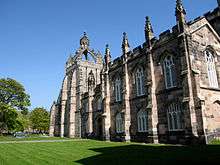University of Aberdeen School of Medicine and Dentistry
| Type | Medical school |
|---|---|
| Established | 1497 |
| Dean | Michael Greaves, FRCPath, FRCP, FRCPE, FRCPSG |
| Students | ~ 850 |
| Location | Aberdeen, Scotland |
| Affiliations | University of Aberdeen |
| Website | The School of Medicine and Dentistry |
Aberdeen University Medical School is the medical school in the College of Life Sciences and Medicine at the University of Aberdeen in Scotland.
Medicine has been taught at the university since the founding of King's College in 1495. Indeed, the university has been described as the first medical school in Scotland and even the English speaking world.[1] Nevertheless, this assertion has been called into question as medical teaching already existed at St. Andrews, Oxford and London and even as late as 1787 there were calls "for the establishment of a medical school" in Aberdeen.[2]
In 2013 the Medical School had an annual intake of 168 students and 20 of these came from outwith the UK.[3]
Divisions

The School of Medicine and Dentistry is made up of three divisions:
- Division of Medical and Dental Education
- Division of Applied Health Sciences
- Division of Applied Medicine
Units
- Centre for Rural Health
- Dugald Baird Centre for Research on Women's Health
- Health Economics Research Unit[4]
- Health Services Research Unit[5]
Locations
May2005.jpg)
Today, the school is based in the newly built Suttie Centre for Teaching & Learning on the Foresterhill site in Aberdeen. Undergraduate placements are mainly in hospitals but also in general practice and community settings. The variety of placements offered, both within Aberdeen and in other locations in the Highlands and Islands, allows students to gain experience of both inner-city medicine and to see how healthcare is delivered in areas far removed from large teaching centres.[6]
The main teaching hospitals are in Aberdeen: Aberdeen Royal Infirmary, Aberdeen Maternity Hospital, the Royal Aberdeen Children's Hospital, Woodend Hospital, Royal Cornhill Hospital and the Woolmanhill Hospital.
Teaching is also provided in Inverness: mainly at Raigmore Hospital and also New Craigs Hospital. Elgin: at Dr Gray's Hospital. In Fort William: Belford Hospital. In Stornoway, Isle of Lewis: Western Isles Hospital. In Kirkwall, Orkney: Balfour Hospital. In Lerwick, Shetland: Gilbert Bain Hospital. In Wick: Caithness General Hospital
People
The current Dean of the School is Michael Greaves, a Consultant Haematologist. There are two active Regius Professorships, the Regius Chair of Medicine and Regius Chair of Surgery. The Regius Chairs of Midwifery and Anatomy are in abeyance.
Division of Medical and Dental Education
The University of Aberdeen offers undergraduate courses in medicine (MB ChB), dentistry (BDS) and a BSc programme in Health Science.[7]
Postgraduate degrees are offered as taught courses, generally leading to the degree of Master of Science (MSc), and as research degrees either at a master's (MSc, MRes, ChM) level or at doctoral (PhD, MD) level.[8]
Courses
In common with other Scottish medical schools, Aberdeen offers a five-year programme, leading to the award of the degrees of Bachelor of Medicine and Bachelor of Surgery, MB ChB. Most teaching is traditional and didactic and problem-based learning is used rarely, unlike in Glasgow. The course is divided into four Phases, detailed below. There is also the opportunity to undertake a further year of study to gain a BSc (Hons) in Medical Science.[6]

The Division of Medical and Dental Education also offers an intercalated BScMedSci (Hons) in Medical Science,[9] usually at the end of Phase II. The programme, which comprises both taught and research elements, is one year long and allows study in depth of an area of biomedical or clinical science. Appropriate training is provided. Each student works on an individual research project of their choice. By the end of the programme students are able to undertake and critically evaluate research and understand the basic principles of research methodology.[6]
Medical Society (Medsoc)
Aberdeen Medsoc was a society set-up originally to bring medical students together in a social capacity. It is the oldest Aberdeen University Student Society and today it has over 600 members. Annual social activities include Beerienteering, Medsoc Ball, Doctors v Medics Sports Day, Medsoc Revue and most recently a Fashion Show with proceeds going to a local children's charity.
There are a range of societies and groups that are open to medical and dental students, catering for a variety of interests.[10]
Famous alumni
- Robert Brown – discoverer of Brownian motion
- Sir Graeme Catto — president of the General Medical Council
- John James Richard Macleod — co-discoverer of insulin and Nobel Prize winner
- Sir Patrick Manson — "Father of Tropical Medicine"
- Sir Alexander Ogston — discoverer of Staphylococcus aureus
- The Very Reverend Gordon McPhate – Dean of Chester Cathedral
- Surgeon Major Peter Shepherd – pioneer of first aid for civilians.
References
- ↑ Carter, Jennifer (1994). Crown and Gown: Illustrated History of the University of Aberdeen, 1495-1995. Aberdeen: Aberdeen University Press.
- ↑ A complete collection of the papers ... - Google Books
- ↑ "FAQs: Admission Data 2013 Entry". University of Aberdeen. Retrieved 7 June 2014.
- ↑ "Health Economics Research Unit". University of Aberdeen. Retrieved 9 October 2009.
- ↑ "Health Services Research Unit". University of Aberdeen. Retrieved 9 October 2007.
- 1 2 3 "Sudy here: undergraduate: medicine". University of Aberdeen. Retrieved 16 June 2014.
- ↑ "About the School". School of Medicine and Dentistry, University of Aberdeen. Retrieved 26 April 2014.
- ↑ "Research". University of Aberdeen. Retrieved 7 June 2014.
- ↑ "Intercalated BSc Med Sci Degree". University of Aberdeen. Retrieved 27 April 2014.
- ↑ "Registered student societies". School of Medicine and Dentistry, University of Aberdeen. Retrieved 27 April 2014.
Coordinates: 57°09′23″N 2°08′03″W / 57.1564°N 2.1343°W
